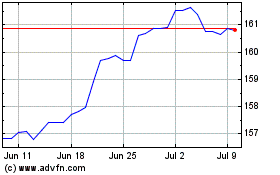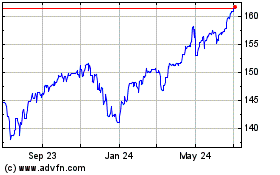U.S. Dollar Weakens As Retail Sales Disappoint
May 12 2017 - 5:32AM
RTTF2
The U.S. dollar dropped against its major counterparts in the
European session on Friday, along with treasury yields, following
the release of a data showing smaller than expected increase in
U.S. retail sales in April, which indicates a slowdown in economy
at the start of the second quarter.
Data from the Commerce Department showed that retail sales
climbed by 0.4 percent in April compared to economist estimates for
0.6 percent growth.
However, the report also said retail sales inched up by a
revised 0.1 percent in March versus the 0.2 percent drop originally
reported.
Excluding a rebound in auto sales, retail sales rose by 0.3
percent in April, matching the increase seen in the previous month
as well as economist estimates.
A separate report from the Labor Department showed that consumer
prices rebounded in line with economist estimates in the month of
April.
The Labor Department said its consumer price index rose by 0.2
percent in April after falling by 0.3 percent in March.
Excluding food and energy prices, core consumer prices inched up
by 0.1 percent in April after dipping by 0.1 percent in March. Core
prices had been expected to rise by 0.2 percent.
The treasury yields declined after the data, with the benchmark
yield on 10-year treasuries falling by 2.36 percent, while that of
2-year equivalent was lower by 1.31 percent. Yields move inversely
to bond prices.
Investors await the University of Michigan's preliminary
consumer sentiment index for May and business inventories for March
to assess the strength of the economy.
The greenback held steady against its major counterparts in the
Asian session.
Pulling away from an early high of 113.95 against the yen, the
greenback edged down to 113.52. The greenback is likely to find
support around the 112.00 zone.
Data from the Bank of Japan showed that Japan's M2 money stock
rose 4.3 percent on year in April, coming in at 975.5 trillion
yen.
That was in line with expectations and up from 4.2 percent in
March following a downward revision from 4.3 percent.
The greenback retreated to 1.2888 against the pound, from an
8-day high of 1.2844 hit at 8:15 am ET. On the downside, 1.30 is
possibly seen as the next support level for the greenback.
The greenback reversed from an early high of 1.0086 against the
Swiss franc, edging lower to a 2-day low of 1.0055. Continuation of
the greenback-franc's downtrend may see it challenging support
around 0.99 the mark.
The greenback weakened to a 3-day low of 1.0912 against the
euro, after having advanced to 1.0856 at 3:00 am ET. If the
greenback extends slide, 1.12 is possibly seen as its next support
level.
Figures from Eurostat showed that Eurozone industrial production
decreased for the second straight month in March on weak energy
output.
Industrial output slid unexpectedly by 0.1 percent
month-on-month in March, the same pace of growth as seen in
February. Production was forecast to climb 0.3 percent.
The greenback pared gains to 1.3682 against the loonie and
0.6868 against the kiwi, from its early highs of 1.3742 and 0.6827,
respectively. On the downside, 1.35 and 0.70 are likely seen as the
next support levels for the greenback against the loonie and the
kiwi, respectively.
The greenback that ended Thursday's trading at 0.7379 against
the aussie declined to a 4-day low of 0.7417. The greenback is
poised to target support around the 0.76 mark.
Looking ahead, U.S. business inventories for March and
University of Michigan's preliminary consumer sentiment index for
May are set for release shortly.
Philadelphia Fed President Patrick Harker speaks about the
economic outlook at Drexel University, in Philadelphia at 12:30 pm
ET.
US Dollar vs Yen (FX:USDJPY)
Forex Chart
From Mar 2024 to Apr 2024

US Dollar vs Yen (FX:USDJPY)
Forex Chart
From Apr 2023 to Apr 2024
